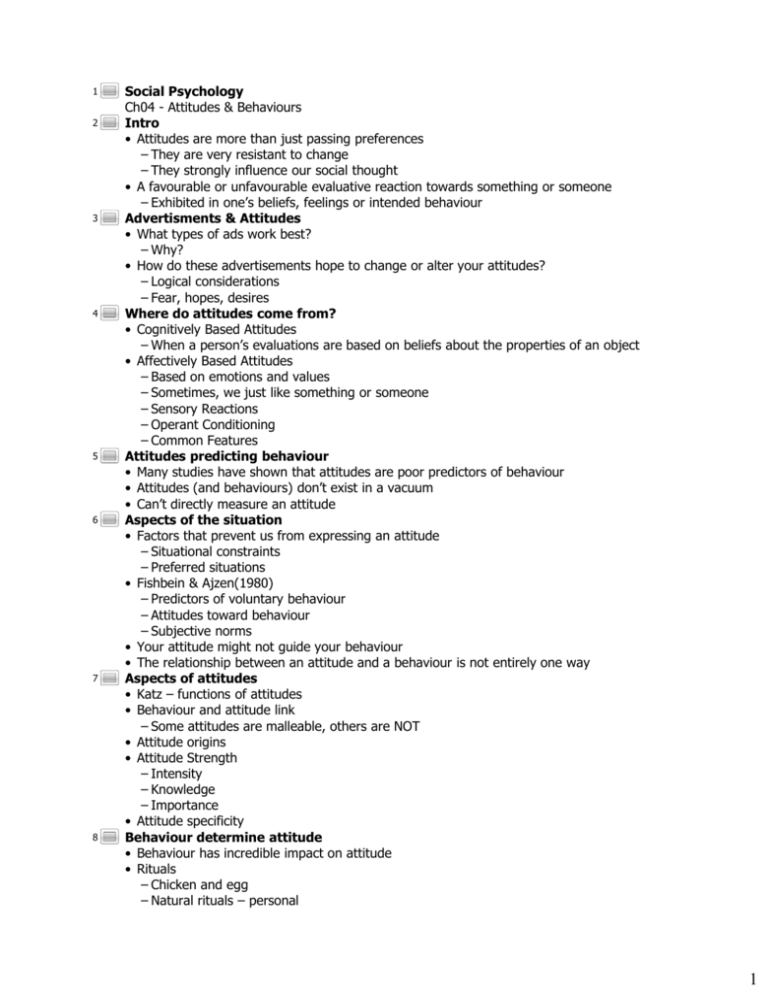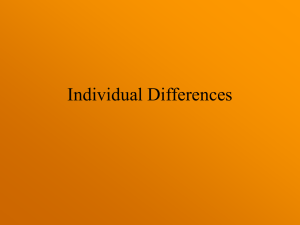Social Psychology Ch04 - Attitudes & Behaviours Intro • Attitudes are
advertisement

1 2 3 4 5 6 7 8 Social Psychology Ch04 - Attitudes & Behaviours Intro • Attitudes are more than just passing preferences – They are very resistant to change – They strongly influence our social thought • A favourable or unfavourable evaluative reaction towards something or someone – Exhibited in one‟s beliefs, feelings or intended behaviour Advertisments & Attitudes • What types of ads work best? – Why? • How do these advertisements hope to change or alter your attitudes? – Logical considerations – Fear, hopes, desires Where do attitudes come from? • Cognitively Based Attitudes – When a person‟s evaluations are based on beliefs about the properties of an object • Affectively Based Attitudes – Based on emotions and values – Sometimes, we just like something or someone – Sensory Reactions – Operant Conditioning – Common Features Attitudes predicting behaviour • Many studies have shown that attitudes are poor predictors of behaviour • Attitudes (and behaviours) don‟t exist in a vacuum • Can‟t directly measure an attitude Aspects of the situation • Factors that prevent us from expressing an attitude – Situational constraints – Preferred situations • Fishbein & Ajzen(1980) – Predictors of voluntary behaviour – Attitudes toward behaviour – Subjective norms • Your attitude might not guide your behaviour • The relationship between an attitude and a behaviour is not entirely one way Aspects of attitudes • Katz – functions of attitudes • Behaviour and attitude link – Some attitudes are malleable, others are NOT • Attitude origins • Attitude Strength – Intensity – Knowledge – Importance • Attitude specificity Behaviour determine attitude • Behaviour has incredible impact on attitude • Rituals – Chicken and egg – Natural rituals – personal – Societal rituals 9 1 8 9 10 11 12 13 14 15 16 – Societal rituals • Indoctrination rituals B to A – Role playing • Groups have well defined roles – Expectations of behaviour • Most of us belong to more than one group – Therefore, many different expectations of behaviour depending on situation • Potential costs – Identity loss – Inconsistent actions Role Playing con’t • Zimbardo et al. (1973) www.prisonexp.org – Potential cost of role playing – 2 week observation on role playing behaviour – Everyone knew it was an experiment – Compelling roles – Ethics Role Playing con’t • Cost of acting inconsistently • • Role expectations are problematic when they are arbitrary and unfair – Gender or Ethnic background – Changes in Society – Perpetuation of statistics Foot in the door phenomenon • Small request followed by larger request – Salesman – Teaching example • Triggers an informational social influence • Hard to resist • Can be extremely long lived Door in the face technique • Somewhat opposite to foot in door technique • Large request followed by smaller request • Cialdini – volunteers to help teens • Reciprocity principle • Effect is fairly short lived Good acts and attitudes • Attitudes are hard to change – Slow steady progress • Governments enacting laws to change attitudes – Smoking bans – Computers (societal pressure not government) – Social movements Attitude Survey Behaviour Survey • Please indicate whether or not you have performed each of the following actions: • Yes No 1. I take time to engage in regular physical exercise at least three times a week. • Yes No 2. I regularly eat at least five servings of fresh fruits and vegetables each day. • Yes No 3. I voted in the last election for which I was eligible. • Yes No 4. Within the last year, I have personally done something to address the problem of homelessness (e.g., made a charitable contribution, talked with a homeless person, wrote my Member of Parliament regarding the problem of homelessness). 17 2 17 18 19 20 wrote my Member of Parliament regarding the problem of homelessness). Why do actions affect attitudes? • Cognitive Dissonance theory – Internal justification for actions • Self Presentation Theory – Expression of attitudes to indicate consistence • Self Perception Theory – Our actions are self revealing Cognitive Dissonance • Tension arises when a person is aware of 2 inconsistent cognitions • We strive to maintain consonance – Dissonance is unpleasant – We must therefore justify our actions • Dissonance reduction – Insufficient justification effect – Behaviour change - Attitude change • Dissonance reduction paradigms – Threat for eliminating pro-attitudinal behaviour – Threat during initiation leads to attitude change Self presentation theory • Impression management • Self Monitoring – High and low self monitoring – Neither is necessary “good” or „bad” – Friendship patterns • Activity vs. affective based orientation – Response to advertising appeals Self Perception Theory • Although this theory might seem kind of flaky at first – “I knew it all along” • Smiling makes people happier • Frowning makes people sadder/angrier • This not only effects you but the people around you – Hospice training – smiles all around – Not just for the patients, but for the other staff 3









